Guess who wants to go first when it’s decision time at an Autocar Handling Day test and you have to take your turn to sit down at our veteran Windows laptop (no brutish jabbing at the keyboard, please; it’s pre-war) and type your final scores into the all-knowing spreadsheet of doom? Nobody – that’s who. Trust me, there’s much less ‘politeness’ when we open the pit lane.
From urgent phone calls to bursting toilet commitments, every stalling tactic you can think of suddenly comes into play in order to prevent a given road tester from being the first to vote, and therefore being unable to sneak a peek at his colleagues’ rankings before committing his own. As the bloke who usually sets up the Excel score sheet, my votes are often the first down – but the queue behind me to take up position in the hot seat is slower forming than a conga line at a state funeral.
Britain's best affordable driver's car 2019 - part one
Mercifully, it didn’t come to the locking of doors and shouting like John Bercow in the bijou briefing room of Llandow Circuit this year. Like me, judges Prior, Lane, Davis and Calo all had to pick a final top three from the field of nine cars we’d assembled and award three points to their favourite, two to second place and one to third. With performance value and usability in mind, therefore, as well as outright driver appeal, we all duly obliged; and a podium made up of two full-sized, front-driven, manual- gearboxed hot hatchbacks and the only rear-driven sports car in the field emerged.

In no particular order, then, the Honda Civic Type R and Mazda MX-5 made the cut – previous annual Britain’s Best Affordable Driver’s Car champions in both cases – as well as the test’s freshest-arriving meat: the Focus ST.
Quite a podium, that. Much as some of us had hoped that the sharp end of the competition might be a bit closer fought, truly outstanding driver’s cars have a habit of, well, standing out; and while all five judges had both the Honda and Mazda in their top order, only one overlooked the Ford. It was a terse ‘nul points’ for the Volkswagen Golf GTI TCR, Mini John Cooper Works, Leon Cupra R ST and MeÃgane RS 300 Trophy. That may seem tough on cars that weren’t short on driver appeal by any means, but, contrary to appearances, I guess we’re a tough bunch. It was a solitary point, meanwhile – but no podium place – for the i30 N Fastback. It was universally saluted for being a performance car of intriguing potential and made of all the right ingredients, albeit ones not quite blended and brought together with flawless skill.
Which brings us, inevitably, to the sharp end of this contest; and to what exactly separates one of the greatest hot hatchback debutants of the past several years from what’s probably the most widely anticipated of 2019. Would either be good enough to force its way between Mazda’s affordable rear-driven sporting icon and another BBADC title? Our jury had plenty to say on the former question, but was split on the latter; and so our 2019 champion ended up taking the golden biscuit by a margin of just three points.
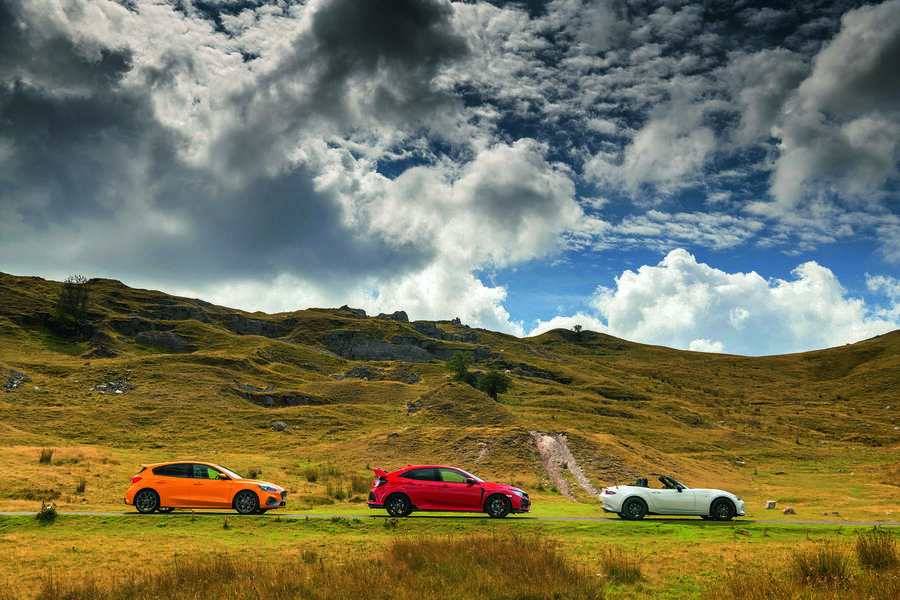
Both on road and track, there’s quite a big difference between the ways in which the Focus ST and Civic Type R go about establishing their respective cases to be considered hot hatchback top dog. Conveniently enough, acknowledging the strengths of one only serves to shine a light on the weaknesses of the other – and picking either meant becoming aware of your own tastes in fast front-drivers as much as anything.
If you like your hot hatchbacks relatively small, lively, agile and dynamically effusive, for example, consider yourself a Focus ST sort of person. The Ford goes bigger than the Honda on character and noise, on steering response and handling balance, and on tactile feedback and instant driver engagement; whereas, in a simpler sense, the Honda Civic just goes big – on size, on pace and on visual attitude.
But whereas the Focus’s chief assets as a driver’s car might be the vivacity and accessibility right there on the surface of its motive character, what really convinces you about the Civic is what it holds in reserve – only to be uncovered when you wring out its motor to high revs, carry that extra speed you pick up around corner and over bump, and unearth the remarkable pace and composure that lies beneath. So if you like to go fast – on track, I would recommend, given that this Honda gives up very little pace to sports cars of two or three times its price – you’ll be a Civic Type R type of, well, type.
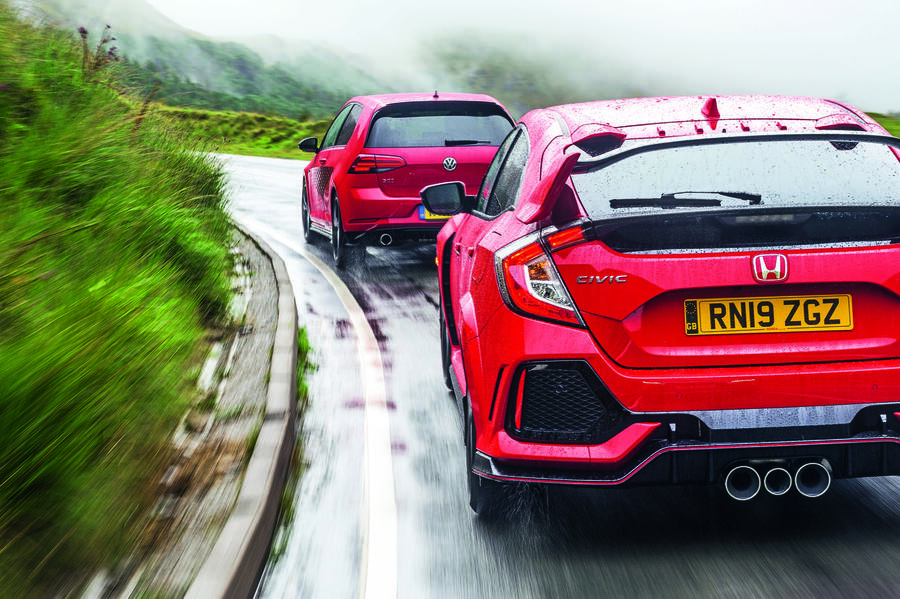
The Focus’s engine sounds better and it responds slightly more smartly and strongly from middling revs. It’s the motor you’d pick for give-and- take driving on the road, warbling away as distinctively as it does, and giving the car a really muscly turn of speed out of tighter bends. The Civic’s smaller four-pot needs to take a bigger breath before it gets going and that doesn’t really happen until it’s spinning above 4500rpm, but it revs all the way to 7000rpm, develops notably more high-end power than the Focus and sounds simpler but more authentic than the Ford. Judged on engines alone, then, the two cars would be level pegging.
Throw gearboxes into the mix as well and the Honda nudges ahead, with its slicker and better-defined shift quality. But add in locking front differentials, too, and the Ford fights back, its eLSD making a more instant and powerful contribution to enrich the car’s front-drive handling on the road than the Honda’s simpler mechanical helical diff.
For its steering and on-track handling, however, most judges marked the Civic ahead of the Focus. Davis called the Honda’s rack “superbly weighted, letting you guide the car with supreme confidence”. Calo observed that it was “more natural feeling than in any of the other hot hatchbacks, never making the handling feel nervous but – in tandem with the best engine and gearbox combo of the group – always exciting and rewarding.”
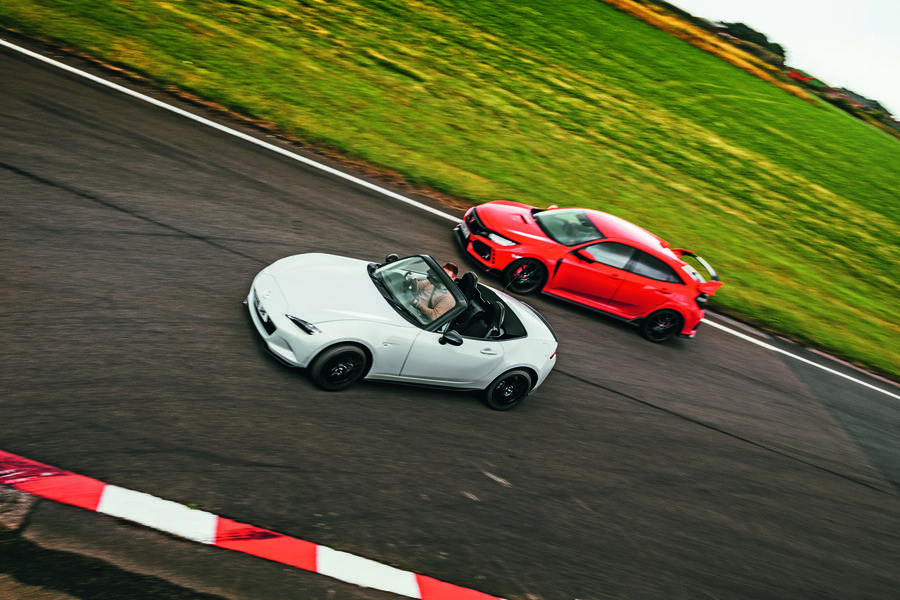
The consensus that slowly emerged was that, for its remarkable on-track grip level, stability and outright pace, the Honda remains today exactly what it was two years ago: the closest thing you can get to a full-blooded touring car racing saloon that you could also put to everyday use on the road. Judge Lane even commented that its body control and sheer readiness to be hustled along, lap after lap, made it the closest thing to a Porsche 911 GT3 you can get with a driven front axle.
Meanwhile, for more than one judge, the handling poise and adjustability hinted at by the Focus ST’s on-road handling simply failed to materialise somehow on Llandow’s surprisingly revealing mix of corners, cambers and kerbs. Although incisive and exciting up to a point, the Ford ultimately fell short of the Honda’s mark for both outright composure and driver reward.
That realisation came as a distinct surprise to anyone who remembered the playful balance of the first- and second-generation Focus STs, but it still couldn’t be denied.

With that acknowledgement, for every judge on the panel, three became two at the very top of the test’s order. Now then: what chance a 181bhp Mazda, operating at a relative disadvantage of more than 50bhp per tonne, might show up a 316bhp Honda and record a second BBADC title for what has become one of the world’s most long-lived and indefatigably brilliant sports cars in its 30th anniversary year?
That was a question pondered long and hard by our testing panel. Their quandary wasn’t because the wonderfully immersive and singularly entertaining drive of the MX-5 didn’t stand out above that of even the very best of the rest of the field, but partly because it seemed so different: delicate rather than forceful, and feelsome, lithe and lovely with it. Moreover, it was because the way you’d use a two-seat sports car would be so different from a big, five-seat family hatchback – and, as we’ve written so many times, usability is the filter through which any dynamic superlatives must soak and drain before becoming truly meaningful in this test.
However, there was simply no denying, suppressing or qualifying the primacy of the MX-5 for the four out of five on the judging panel who put the little Mazda top overall in their scoring. Davis summed up its appeal very well when he noted how much he loved that “on the road, you feel like you can use everything it’s got, and on track, the scope it provides for playing silly buggers is impossible not to take a shine to.” For Calo, it was “a purist’s dream – and if it wasn’t for the curry I’d eaten for lunch starting to repeat on me, I’d have stayed out on track in it all afternoon.” See how insightful we can be?
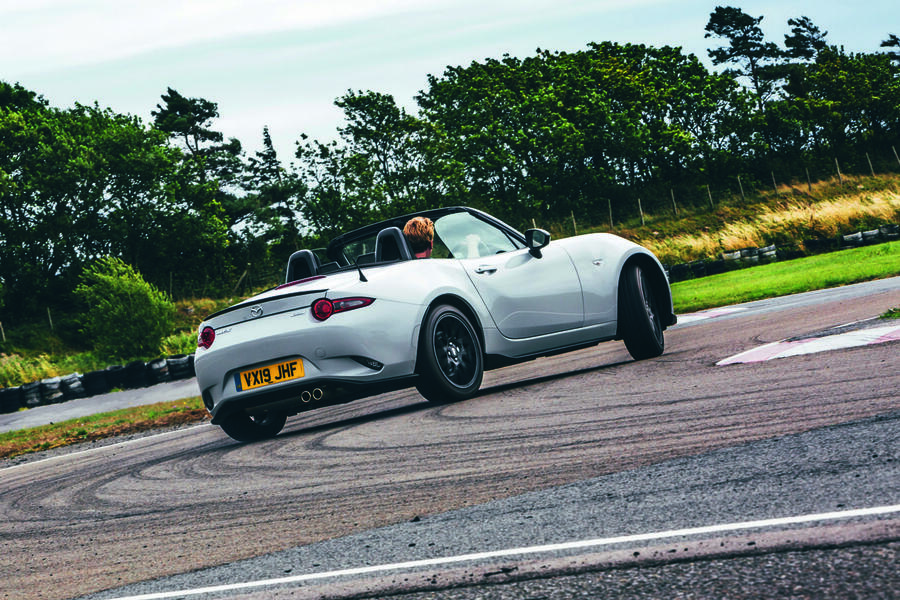
What do you mean you want more detail? Well, for this tester, the process of remembering and anatomising what makes up such a wonderful driving experience is almost as much fun as sampling it in the first place – and will always feel like a privilege. It starts with an abiding sense of compactness: the MX-5, like the Abarth 595 and a little like the Mini but unlike anything else here, fits inside UK lane markings with space to breathe – and when it comes to enjoying a car on a daily basis and on any trip, that’s a really laudable quality.
The car’s performance level is so perfectly matched to its outright grip level and its reserves of body control that to drive it at briskish real-world road pace – between 60mph and 80mph on undulating A- and B-roads – is to feel like you’re experiencing the MX-5 at its absolute best. Nothing else in this field gives you that sense nearly as clearly. Overtaking means wringing that 2.0-litre atmospheric engine out right to the 7200rpm redline in second and third gears, which is made joyful by the car’s pedal weights and its superbly positive, connected-feeling manual gearbox, which is like finding an expensive Swiss movement in a bargain-bucket watch. The car is only as quick from point to point as you’re prepared to make it with your own investment of effort and only as grippy and firm riding as it needs to be to remain secure at high speeds. It continues to ride fluently over bigger lumps and bumps taken around the national speed limit and is so lively and adjustable in its famously absorbing rear-driven handling although I’ve no doubt that our test car’s dynamic credentials were boosted by its particular mechanical specification: a 2.0-litre SE-L Nav (with mechanical slippy diff but without the uprated Bilstein dampers or strut brace of Sport specification) with Mazda’s dealer-fit BBS 17in alloy wheels, Eibach lowered suspension and sports exhaust.
On the road, our winner might have even been the most charming, engaging MX-5 that this tester has ever driven. On the track, it occasionally showed some looseness in its vertical body control and, like all MX-5s, could be made to feel slightly out of its depth when driven really hard by its relatively modest positioning as a compact, lightweight, simple performance car.
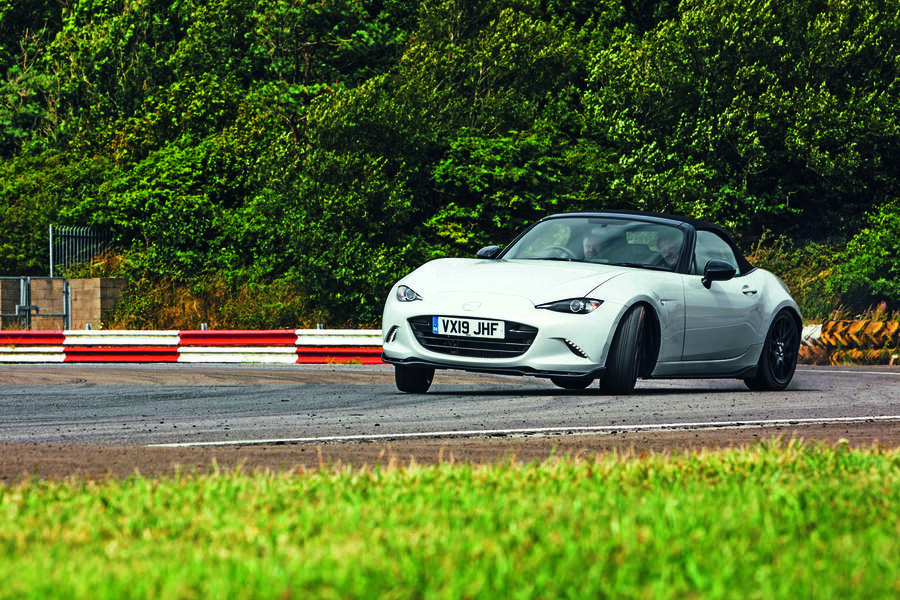
But how much should you penalise a classic one-tonne roadster for falling short of modern hot hatchback track pace? How much credit should you deny it for practicality when it’s entirely comfortable and well mannered – and every bit as usable as at least a couple of the alleged ‘four-seaters’ in this test? How much more convincing, even in 2019, is genuinely effusive charm and truly special sporting handling in an affordable driver’s car than another 20 horsepower, another five seconds off a Nürburgring record, or another few tenths to 62mph?
This, we hope, explains it all: the Mazda MX-5 is Britain’s Best Affordable Driver’s Car of 2019. Happy birthday, little guy.
Sense of speed and the scores
In previous years, we’ve strapped our timing gear to each of the contenders and sent Matt Saunders out to see which can set the quickest lap time. This year, slightly variable weather – and the organisational deficiencies of the road test editor – denied us the necessary time. It’s a good job, then, that fast lap times aren’t directly proportional to fun behind the wheel.
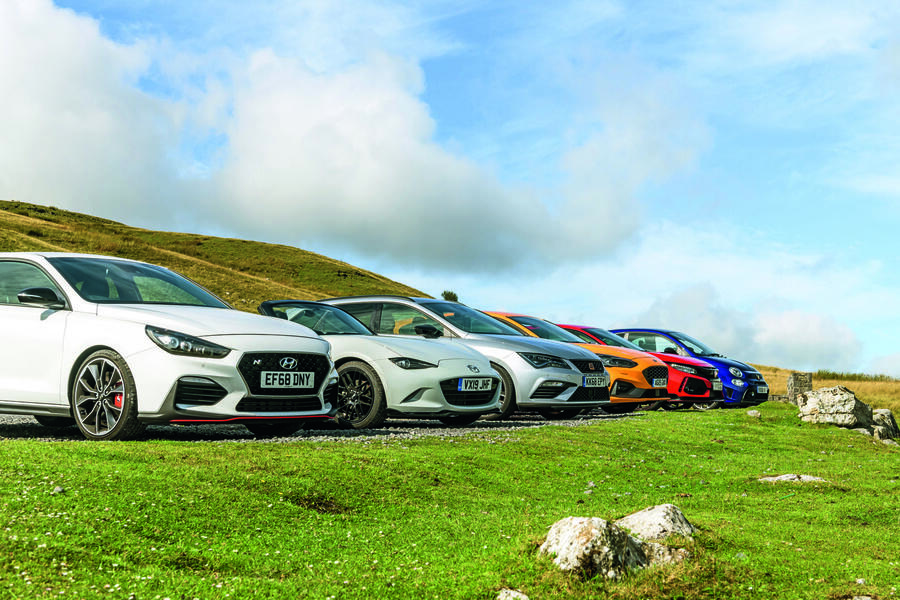
Had we pitched each of these cars against the stopwatch, both previous testing experience and gut instinct suggests that the Civic would have set the pace. The Type R feels devastatingly quick, successfully balancing surgical precision and agility through the tight sections of track at Bus Stop and Devil’s Elbow with masses of grip and accelerative power through the sweeping right-hander that leads on to Hangway Straight. The Mégane manages a similar effect although the heightened agility its four-wheel steering imparts can come across as nervousness.
By comparison, the rear-driven MX-5 feels far more playful. It might lack the outright performance of a lot of the cars here, but it’ll happily allow its rear end to step out into progressive, controllable drifts through Llandow’s tighter bends. The Hyundai is similarly expressive and the temptation to back it into Glue Pot on the brakes and deliberately cause it to over-rotate often proved too strong to resist.
The Golf and the Leon both had rather more serious demeanours, and where the Seat could struggle at times for front-end grip, the Golf’s Cup 2 tyres provided plenty of reliable bite and feel. That said, on track, the Volkswagen’s slower steering did come across as a touch sedate next to the hyper-quick rack fitted to the Focus ST, which came close to the Renault on the grounds of agility, if not outright pace.
The Mini and the Abarth both entertained but a shortage of grip and outright composure (among other things) hampered their effectiveness.
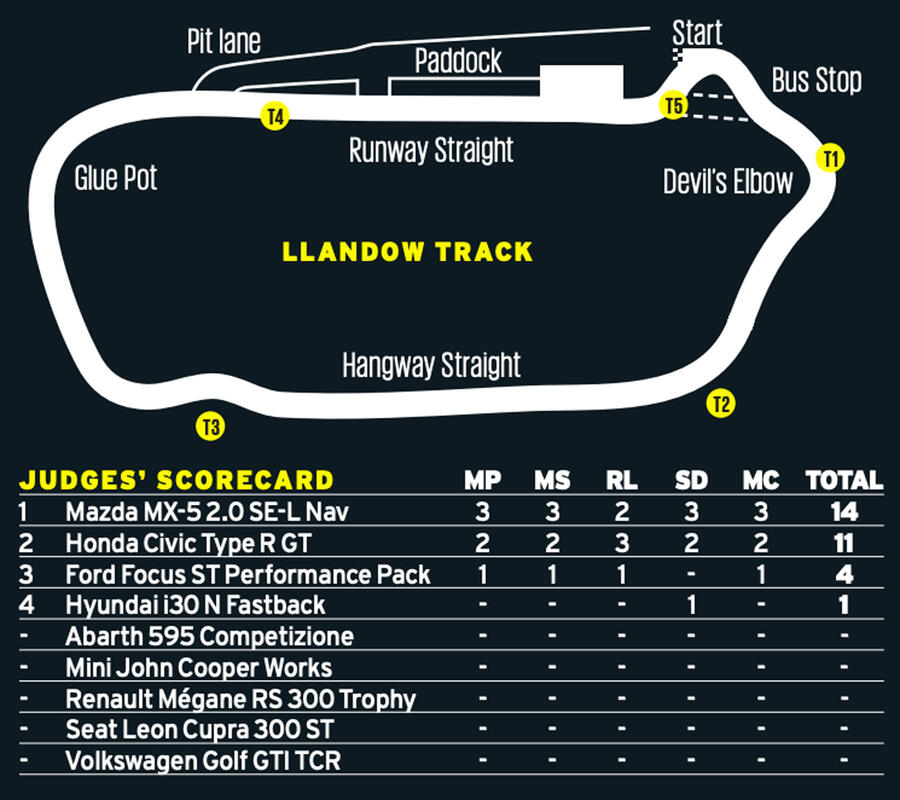
Read more
Britain's best affordable driver's car 2019 - part one​
Get your own affordable driver's car: Our guide to buying a Mazda MX-5 Mk4​











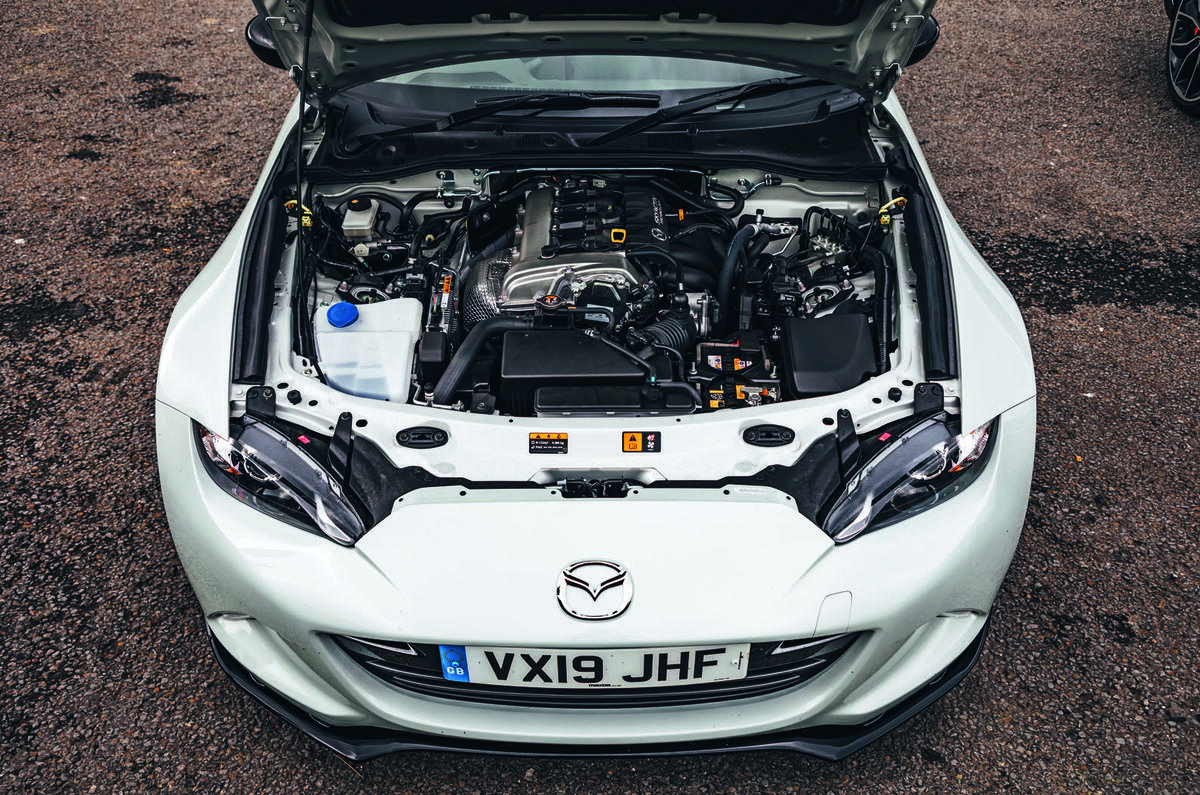












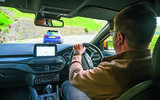
















Join the debate
Add your comment
Plastorit
Thank you for sharing this information
Plastorit
Thank you for sharing this information
Greedier Social Media
The author is well versed in his subject and has provided the content of the blog in a nice way to the readers. Buy Instagaram Followers